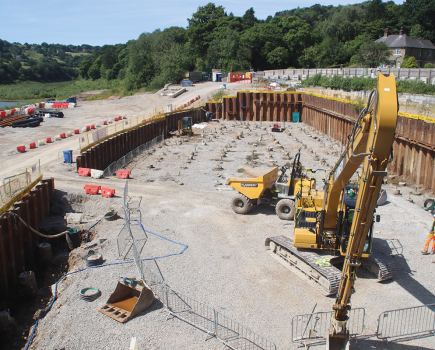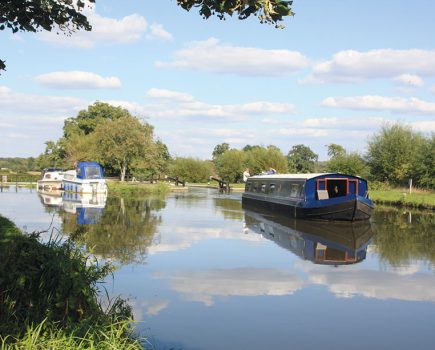The Leeds & Liverpool celebrated its 200th anniversary in 2016. Building it was quite an achievement, and it turned out to become something of a battleground

Words: Anthony Burton
When promoters celebrated the passing of the Act authorising construction of a canal in 1770, they could never have imagined they would have to wait until 1816 to mark the completion of the great enterprise, and how much money was involved.
The cost had been estimated, at dubious accuracy, at £259,777. The final cost was never accurately assessed, but was roughly £1,200,000.

Why did it take 46 years to build the Leeds & Liverpool and how could the costings be so hopelessly wrong? Well, there were problems right from the start.
The plan originated with engineer John Longbotham – in some early records the name is spelt Longbottom – who surveyed a possible route and received financial backing from Bradford wool merchant John Hunslet to start rallying support for an Act of Parliament. At first, the committee consisted entirely of men from the Yorkshire side of the Pennines, but it was soon realised things would never progress unless the western end was represented. But instead of asking Lancashire men to join, a second, separate Lancashire committee was formed.

It may have been optimistic to think the two would reach instant agreement, but no one expected a waterways re-run of the Wars of the Roses.
Longbotham’s original plan for the Leeds end was straightforward. It would start at a junction with the Aire & Calder Navigation and follow the line of the Aire valley, gradually rising until it reached Bingley. To remove the problem of crossing the Pennines, the engineer intended to take the canal far up to the north before turning back to the south. The original idea was to swing right round down to the valleys of the Lancashire Calder and the Ribble to Ormskirk, from where there was a simple run in to Liverpool.
This would reduce the engineering works required, but it made no sense at all to potential investors of Lancashire as Longbotham’s route missed the rapidly growing cotton towns, such as Blackburn and Burnley. The Yorkshire response was to build branch lines to them, but that idea was equally unacceptable. The Lancashire Committee paid for a new survey of their own, with the result being a line even longer than Longbotham’s, which took a similarly evasive route around all obstacles.

With both sides convinced their solution was best, the two schemes were put to arbitration. They went to the man of the moment, the busiest engineer on the canal scene James Brindley. But he was far too busy to take more than a passing interest in the problem and sent his assistant Robert Whitworth to look over the Lancashire route.
He only got as far east as Burnley, when he discovered the levels taken during the survey were out by an astonishing 35ft. He promptly declared the Lancashire surveyors as hopelessly incompetent and pronounced in favour of Longbotham, but this didn’t solve the problem.

The Lancashire side had a new survey done, and this time a compromise was agreed. Each committee would be responsible for designing the route for their end of the canal. It was a solution, but not a happy one.
Early canals, such as this one, were connected to existing river navigations and generally designed to take the craft already in use on older routes. This meant Mersey barges at the Lancashire end and craft from the Aire & Calder at the Yorkshire end. But they weren’t the same size.
As a result, the Lancashire faction, eager to reach the great coalfield around Wigan, set to work building locks able to take vessels up to 72ft long and 14ft wide. At the same time, the Yorkshiremen built locks for vessels only up to 62ft long.

The latter, which came to be known as Leeds & Liverpool short boats, could travel the whole route, but the former could only go as far as Wigan. This could have worked well enough in practice, but what no one had taken into account was the growing network of narrow canals stretching across the country. The now familiar narrow boats could never get past Wigan.
Other problems soon appeared. The original plans called for an aqueduct to cross the Douglas Navigation, but the Douglas authorities pointed out it was far too low to allow their vessels to pass underneath. The Leeds & Liverpool proposed a deep side cutting with locks for access at either end so canal boats could cross the river on the level. This bizarre scheme was never put into practice.

The net result of all this bickering and changes was that investors, unsurprisingly, lost confidence in the scheme so when money started to run out, no one wanted to dig any deeper into their pockets.
Longbotham’s work at the Leeds end did move forward, and it was a bold venture. The canal gradually rose up the valley, at first by single locks, then double, then three-lock staircases and the whole ascent culminated in the famous five-lock staircase at Bingley. Then came the long pound, 17 miles of lock-free travel to Gargrave.
Progress, however, was desperately slow and Longbotham was forced to resign in 1775. He was the scapegoat. The blow left him so badly off that in June 1800, he wrote a begging letter to his old employers. With pride, he pointed to his accomplishments – in the five years he worked for them, he completed 60 miles of canal at a comparatively modest cost of around £160,000.

Old, penniless and with no means of support, he begged them to let him have a small amount as a stipend. The Committee agreed to think things over, but it was the following spring before anyone was sent to see the old engineer, only to find he had died in the winter. It was a sad end for a man who gave us one of the most remarkable engineering works of the age: the Bingley Five.
A new engineer, Richard Owen, was appointed, but by 1782 all work ground to a halt as the company had run out of money. Work languished for eight years before Robert Whitworth was called in to prepare an estimate for finishing the canal. He resurveyed the route and, despite earlier denouncing the Lancashire surveyors’ line, decided the best route would be through Burnley and Blackburn after all.

The new line certainly called for major engineering works, especially the massive embankment that carried the canal at Burnley. His estimate for completing the route was calculated to a nicety: £169,817 15s 5d.
A new Act was obtained, work restarted, engineers came and went and the costs kept rising. By now the canal system had spread over Britain, so it was clear the Leeds & Liverpool could no longer be considered in isolation. A new branch was authorised to run from the Bridgewater Canal through Leigh to join the main line at Wigan.
Whitworth died in 1799 with the canal still far from complete. His successor Samuel Fletcher finally saw it through to completion.

The canal was a success, thanks to a steady demand for coal for the steam-powered mills lining the route and encouraged entrepreneurs to build new mills along its banks. This happened not only in existing mill towns, but in once quiet market towns such as Skipton. One can still see the old mills and the terraces of workers’ cottages built by the canal.
The most spectacular development came in the late 19th century when Sir Titus Salt established his vast new mill beside the canal and built the town of Saltaire to house his workforce.

Unlike many others, the canal continued to thrive in the railway age, until the First World War. In the first rush of patriotic fervour, young boatmen signed up and the canals found themselves short staffed. It was decided some military would be appointed to help keep vital links open, and the Leeds & Liverpool was one of them. But instead of bringing enlisted boatmen back to the waterways, they trained new recruits in the techniques of boat handling.
Soon boat crews were arriving on the northern canal. They were not appointed to help out short-handed crews but strictly segregated on all-military boats. They aroused a good deal of antagonism, largely because they tended to claim automatic right to precedence over other boats at locks. The experiment was never a great success, and made little difference to the running of the canal.
Commercial traffic lasted almost to the end of the 20th century, thanks to one lone carrier Geoff Wheat still running his short boat Lune. He only abandoned the canal when a crane operator dropped a load on the hold, sending it straight through the hull.

Now, 200 years after its official opening, the Leeds & Liverpool is perhaps as busy with boats as it has ever been. The difference is, of course, that today’s boats carry holidaymakers not cargo.
_____________________
You may also like:
200 years of the Leeds & Liverpool celebrated with nine-day voyage
8 of the best pubs along the Leeds & Liverpool
Image(s) provided by:
Archant







